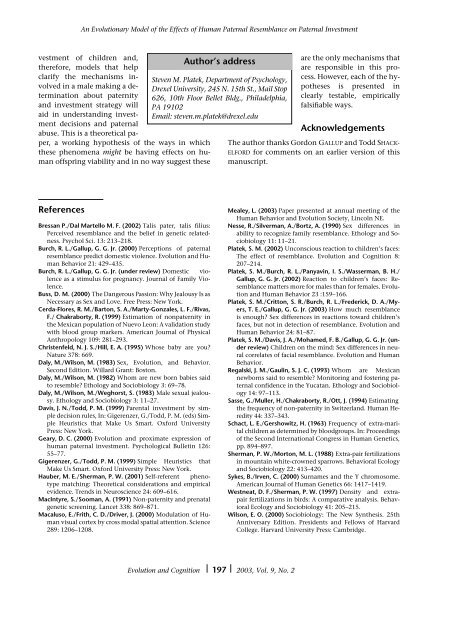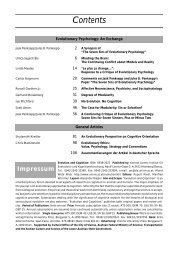Contents - Konrad Lorenz Institute
Contents - Konrad Lorenz Institute
Contents - Konrad Lorenz Institute
You also want an ePaper? Increase the reach of your titles
YUMPU automatically turns print PDFs into web optimized ePapers that Google loves.
An Evolutionary Model of the Effects of Human Paternal Resemblance on Paternal Investment<br />
vestment of children and,<br />
therefore, models that help<br />
clarify the mechanisms involved<br />
in a male making a determination<br />
about paternity<br />
and investment strategy will<br />
aid in understanding investment<br />
decisions and paternal<br />
abuse. This is a theoretical paper,<br />
a working hypothesis of the ways in which<br />
these phenomena might be having effects on human<br />
offspring viability and in no way suggest these<br />
Author’s address<br />
Steven M. Platek, Department of Psychology,<br />
Drexel University, 245 N. 15th St., Mail Stop<br />
626, 10th Floor Bellet Bldg., Philadelphia,<br />
PA 19102<br />
Email: steven.m.platek@drexel.edu<br />
are the only mechanisms that<br />
are responsible in this process.<br />
However, each of the hypotheses<br />
is presented in<br />
clearly testable, empirically<br />
falsifiable ways.<br />
Acknowledgements<br />
The author thanks Gordon GALLUP and Todd SHACK-<br />
ELFORD for comments on an earlier version of this<br />
manuscript.<br />
References<br />
Bressan P./Dal Martello M. F. (2002) Talis pater, talis filius:<br />
Perceived resemblance and the belief in genetic relatedness.<br />
Psychol Sci. 13: 213–218.<br />
Burch, R. L./Gallup, G. G. Jr. (2000) Perceptions of paternal<br />
resemblance predict domestic violence. Evolution and Human<br />
Behavior 21: 429–435.<br />
Burch, R. L./Gallup, G. G. Jr. (under review) Domestic violence<br />
as a stimulus for pregnancy. Journal of Family Violence.<br />
Buss, D. M. (2000) The Dangerous Passion: Why Jealousy Is as<br />
Necessary as Sex and Love. Free Press: New York.<br />
Cerda-Flores, R. M./Barton, S. A./Marty-Gonzales, L. F./Rivas,<br />
F./ Chakraborty, R. (1999) Estimation of nonpaternity in<br />
the Mexican population of Nuevo Leon: A validation study<br />
with blood group markers. American Journal of Physical<br />
Anthropology 109: 281–293.<br />
Christenfeld, N. J. S./Hill, E. A. (1995) Whose baby are you<br />
Nature 378: 669.<br />
Daly, M./Wilson, M. (1983) Sex, Evolution, and Behavior.<br />
Second Edition. Willard Grant: Boston.<br />
Daly, M./Wilson, M. (1982) Whom are new born babies said<br />
to resemble Ethology and Sociobiology 3: 69–78.<br />
Daly, M./Wilson, M./Weghorst, S. (1983) Male sexual jealousy.<br />
Ethology and Sociobiology 3: 11–27.<br />
Davis, J. N./Todd, P. M. (1999) Parental investment by simple<br />
decision rules, In: Gigerenzer, G./Todd, P. M. (eds) Simple<br />
Heuristics that Make Us Smart. Oxford University<br />
Press: New York.<br />
Geary, D. C. (2000) Evolution and proximate expression of<br />
human paternal investment. Psychological Bulletin 126:<br />
55–77.<br />
Gigerenzer, G./Todd, P. M. (1999) Simple Heuristics that<br />
Make Us Smart. Oxford University Press: New York.<br />
Hauber, M. E./Sherman, P. W. (2001) Self-referent phenotype<br />
matching: Theoretical considerations and empirical<br />
evidence. Trends in Neuroscience 24: 609–616.<br />
MacIntyre, S./Sooman, A. (1991) Non-paternity and prenatal<br />
genetic screening. Lancet 338: 869–871.<br />
Macaluso, E./Frith, C. D./Driver, J. (2000) Modulation of Human<br />
visual cortex by cross modal spatial attention. Science<br />
289: 1206–1208.<br />
Mealey, L. (2003) Paper presented at annual meeting of the<br />
Human Behavior and Evolution Society, Lincoln NE.<br />
Nesse, R./Silverman, A./Bortz, A. (1990) Sex differences in<br />
ability to recognize family resemblance. Ethology and Sociobiology<br />
11: 11–21.<br />
Platek, S. M. (2002) Unconscious reaction to children’s faces:<br />
The effect of resemblance. Evolution and Cognition 8:<br />
207–214.<br />
Platek, S. M./Burch, R. L./Panyavin, I. S./Wasserman, B. H./<br />
Gallup, G. G. Jr. (2002) Reaction to children’s faces: Resemblance<br />
matters more for males than for females. Evolution<br />
and Human Behavior 23 :159–166.<br />
Platek, S. M./Critton, S. R./Burch, R. L./Frederick, D. A./Myers,<br />
T. E./Gallup, G. G. Jr. (2003) How much resemblance<br />
is enough Sex differences in reactions toward children’s<br />
faces, but not in detection of resemblance. Evolution and<br />
Human Behavior 24: 81–87.<br />
Platek, S. M./Davis, J. A./Mohamed, F. B./Gallup, G. G. Jr. (under<br />
review) Children on the mind: Sex differences in neural<br />
correlates of facial resemblance. Evolution and Human<br />
Behavior.<br />
Regalski, J. M./Gaulin, S. J. C. (1993) Whom are Mexican<br />
newborns said to resemble Monitoring and fostering paternal<br />
confidence in the Yucatan. Ethology and Sociobiology<br />
14: 97–113.<br />
Sasse, G./Muller, H./Chakraborty, R./Ott, J. (1994) Estimating<br />
the frequency of non-paternity in Switzerland. Human Heredity<br />
44: 337–343.<br />
Schact, L. E./Gershowitz, H. (1963) Frequency of extra-marital<br />
children as determined by bloodgroups. In: Proceedings<br />
of the Second International Congress in Human Genetics,<br />
pp. 894–897.<br />
Sherman, P. W./Morton, M. L. (1988) Extra-pair fertilizations<br />
in mountain white-crowned sparrows. Behavioral Ecology<br />
and Sociobiology 22: 413–420.<br />
Sykes, B./Irven, C. (2000) Surnames and the Y chromosome.<br />
American Journal of Human Genetics 66: 1417–1419.<br />
Westneat, D. F./Sherman, P. W. (1997) Density and extrapair<br />
fertilizations in birds: A comparative analysis. Behavioral<br />
Ecology and Sociobiology 41: 205–215.<br />
Wilson, E. O. (2000) Sociobiology: The New Synthesis. 25th<br />
Anniversary Edition. Presidents and Fellows of Harvard<br />
College. Harvard University Press: Cambridge.<br />
Evolution and Cognition ❘ 197 ❘ 2003, Vol. 9, No. 2








